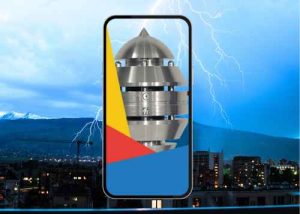Lightning rods play a crucial role in protecting buildings and infrastructure against lightning. They capture the electrical energy generated by lightning and allow it to be conducted to earth, minimizing the risk of fire, property damage and injury. However, for them to remain effective, lightning rods must be regularly maintained in accordance with current standards. In this article, we will explore the steps of maintaining lightning rods, with a particular focus on the use of connected lightning rods Paraton@ir®, associated with the communication option Contactact@ir® System and to the LPS Manager application.
The importance of lightning rod maintenance
The maintenance of lightning rods is of crucial importance because these devices are subject to severe environmental conditions. Lightning, bad weather, corrosion and mechanical impacts can affect their effectiveness over time. Proper maintenance ensures that lightning rods remain operational to protect structures against lightning, reducing risks to people and property.
Current standards
Maintenance of lightning rods must be carried out in accordance with current standards, such as standard NF C 17-102:2001 in France. These standards define specific requirements for inspection, testing and maintenance of lightning rods to ensure their proper operation. Compliance with these standards is essential to ensure the safety of the occupants of a building or structure.
Connected lightning rods Paraton@ir®
Connected lightning rods Paraton@ir®, associated with the communication option Contactact@ir® System are modern devices that integrate sensors and communication technologies to monitor the status of the lightning rod in real time. They allow building owners to receive accurate information on the condition of their lightning rods, making preventive maintenance much easier.
Lightning rod maintenance steps with Paraton@ir® And LPS Manager
1. Regular visual inspection
The first step in maintenance is a regular visual inspection of the lightning rod. This inspection must be carried out at least once a year or after a lightning strike, in accordance with current standards. Connected lightning rods Paraton@ir® facilitate this task by providing real-time information on the status of the lightning rod via the LPS Manager application. Users can thus visually check the status of the device remotely, which reduces the risks associated with climbing onto the roof.
2. Operation tests
In addition to visual inspection, it is essential to regularly test the operation of the lightning rod. Tests must be carried out in accordance with current standards, once a year or after a lightning strike. Connected lightning rods Paraton@ir® can be monitored remotely for functional tests, making this task much easier.
3. Preventative maintenance
Preventive maintenance is a crucial step to guarantee the longevity and effectiveness of lightning rods. This can include replacing faulty parts, lubricating grounding mechanisms, cleaning components, and much more. The LPS Manager app provided specific information on the stresses experienced by the lightning protection system and the operation of the Paraton@ir® making it possible to target upkeep and maintenance operations of the system.
4. Inspection and maintenance reports
Documentation is an essential aspect of lightning rod maintenance. The LPS Manager app is the most effective tool for automatically generating inspection and maintenance reports that record inspections, tests and interventions performed. These reports can be stored and shared to demonstrate compliance with standards and make it easier to track maintenance over time.
Conclusion
The maintenance of lightning rods and lightning protection systems as a whole is an essential component of the safety of buildings and infrastructure. Connected lightning rods Paraton@ir®, associated with the communication option Contactact@ir® System And the LPS Manager application simplify this process by providing real-time information, automating tests and generating inspection and maintenance reports. By following current standards and using modern tools available, building owners can ensure the continued protection of their property and their occupants against the dangers of lightning.

